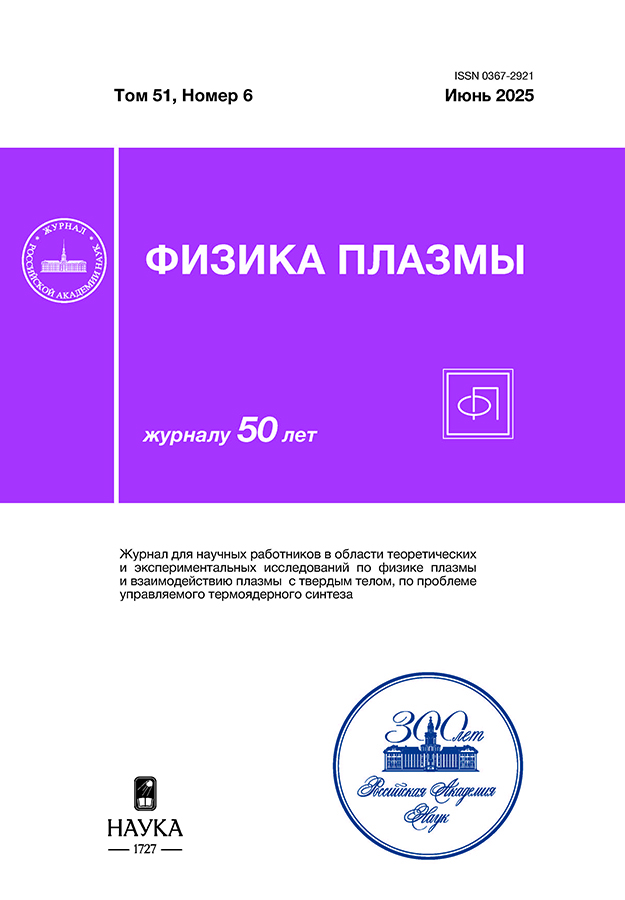Effect of plasma flows in a magnetic field on the dusty structures in different inert gases
- Authors: Pavlov S.I.1, Dzlieva E.S.1, Dyachkov L.G.2, Golubev M.S.1, Morozova М.B.1, Novkov L.A.1, Karasev V.Y.1
-
Affiliations:
- St. Petersburg State University
- Joint Institute for High Temperatures, Russian Academy of Sciences
- Issue: Vol 50, No 8 (2024)
- Pages: 924-930
- Section: ПЫЛЕВАЯ ПЛАЗМА
- URL: https://modernonco.orscience.ru/0367-2921/article/view/677459
- DOI: https://doi.org/10.31857/S0367292124080079
- EDN: https://elibrary.ru/OAWVHJ
- ID: 677459
Cite item
Abstract
The effect of the dust grain flows on a spatial dusty structure in a stratum of a glow discharge in two inert gases (neon and argon) in a weak magnetic field was studied. The discharge parameters were determined that are necessary for the creation of three-dimensional dusty structures made from dust grains of the same size in both gases in a magnetic field. The dependences were obtained of the angular velocities of the dusty structures in the two gases on the magnetic field and on the gas pressure. The rotation speeds of the dust grains in the magnetic field were used to compare the ion fluxes acting on the dust formations.
Full Text
About the authors
S. I. Pavlov
St. Petersburg State University
Author for correspondence.
Email: s.i.pavlov@spbu.ru
Russian Federation, St. Petersburg
E. S. Dzlieva
St. Petersburg State University
Email: s.i.pavlov@spbu.ru
Russian Federation, St. Petersburg
L. G. Dyachkov
Joint Institute for High Temperatures, Russian Academy of Sciences
Email: s.i.pavlov@spbu.ru
Russian Federation, Moscow
M. S. Golubev
St. Petersburg State University
Email: s.i.pavlov@spbu.ru
Russian Federation, St. Petersburg
М. B. Morozova
St. Petersburg State University
Email: s.i.pavlov@spbu.ru
Russian Federation, St. Petersburg
L. A. Novkov
St. Petersburg State University
Email: s.i.pavlov@spbu.ru
Russian Federation, St. Petersburg
V. Yu. Karasev
St. Petersburg State University
Email: plasmadust@yandex.ru
Russian Federation, St. Petersburg
References
- Fortov V.E., and Morfill G.E. Complex and Dusty Plasmas: From Laboratory to Space. New York: Taylor and Francis, 2010.
- Фортов В.Е., Петров О.Ф., Молотков В.И. и др. // УФН. 2004. Т. 174. № 5. C. 495.
- Карасев В.Ю., Дзлиева Е.С., Павлов С.И. Лабораторная пылевая плазма в магнитном поле. СПб.: Свое издательство, 2016.
- Samarian A.A. and James B.W. // Plasma Phys. Control. Fusion 2005. V. 47. P. B629.
- Beckers J., Ockenga T., Wolter M., Stoffels W.W., van Dijk J., Kersten H., and Kroesen G.M.W. // Phys. Rev. Lett. 2011. V. 106.P. 115002.
- Ashrafi K.S., Yousefi R., Chen M.D., Matthews L.S. and Hyde T.W. // Phys. Rev. E. 2020.V. 102. P. 043210.
- Karasev V.Yu., Dzlieva E.S. and Pavlov S.I. // EPL 2015. V. 110 P. 55002.
- Майоров С. А. // Физика плазмы. 2009. Т. 35. С. 869.
- Антипов С.Н., Васильев М.М., Майоров С.А., Петров О.Ф., Фортов В.Е. // ЖЭТФ. 2011. Т. 139. № 3. С. 554.
- Maiorov S.A., Ramazanov T.S., Dzhumagulova K.N., Jumabekov A.N., Dosbolayev M.K. // Physics of Plasmas. 2008. Т. 15. № 9. P. 093701.
- Дзлиева Е.C., Майоров С. А., Новиков Л. А., Павлов С. И., Балабас М. В., Крылов И. Р., Карасев В. Ю. // Физика плазмы. 2022. Т. 48. № 10. С. 1.
- Дзлиева Е.С., Ермоленко М.А., Карасев В.Ю., Павлов С.И., Новиков Л.А., Майоров С.А. // Письма в ЖЭТФ. 2014. Т. 100. № 11–12. С. 801.
- Pavlov S.I., Dzlieva E.S., Karasev V.Y., Ermolenko M.A., Novikov L.A., Maiorov S.A. // Contrib. to Plasma Physics. 2016. Т. 56. № 3–4. С. 221.
- Павлов С. И., Дзлиева Е.C., Дьячков Л. Г., Новиков Л. А., Балабас М. В., Карасев В. Ю. // Физика плазмы. 2023. Т. 49. № 10. С. 995.
- Райзер Ю.П. Физика газового разряда. М.: Наука, 1992.
- Грановский В.Л. Электрический ток в газе. Установившийся ток. М.: Наука, 1971.
- Дзлиева Е. C., Карасев В.Ю., Новиков Л.А., Павлов С.И., Голубев М.С., Машек И.Ч. // ЖТФ. 2023. Т. 93. № 10. С. 1429.
- Майоров С.А. // Краткие сообщения по физике ФИАН. 2012. № 2. С. 31–39.
- Майоров С.А., Клумов Б.А. // Краткие сообщения по физике ФИАН. 2013. № 10. С. 19–32.
- Nedospasov A.V. // EPL. 2013. V. 103 P. 25001.
- Васильев М.М., Дьячков Л.Г., Антипов С.Н., Петров О.Ф., Фортов В.Е. // Письма в ЖЭТФ. 2007. Т. 86. № 6. С. 414.
- Novikov L. A., Pavlov S.I., Dzlieva E.S., Tarasov S.A., Yanitsin D.V., Karasev V.Yu. // High Temp. Mater. Processes. 2024. V. 28. I. 1. P. 55.
- Ваулина O. С., Петров О. Ф., Фортов В. Е., Храпак А. Г., Храпак С. А. Пылевая плазма, Эксперимент и теория. М.: Физматлит, 2009.
- Kononov E.A., Vasiliev M.M., Vasilieva E.V., Petrov O.F. // Nanomaterials. 2021. V. 11. P. 2931.
- Golubovskii Yu.B., Kozakov R.V., Maiorov V.A., Behnke J. and Behnke J. F. // Phys. Rev. E. 2000. V. 62. P. 2707.
- Голубовский Ю. Б., Кудрявцев А.А., Некучаев В.О., Порохова И.А., Цендин Л.Д. Кинетика электронов в неравновесной газоразрядной плазме. СПб.: Издательство С.-Пб. университета, 2004.
Supplementary files















